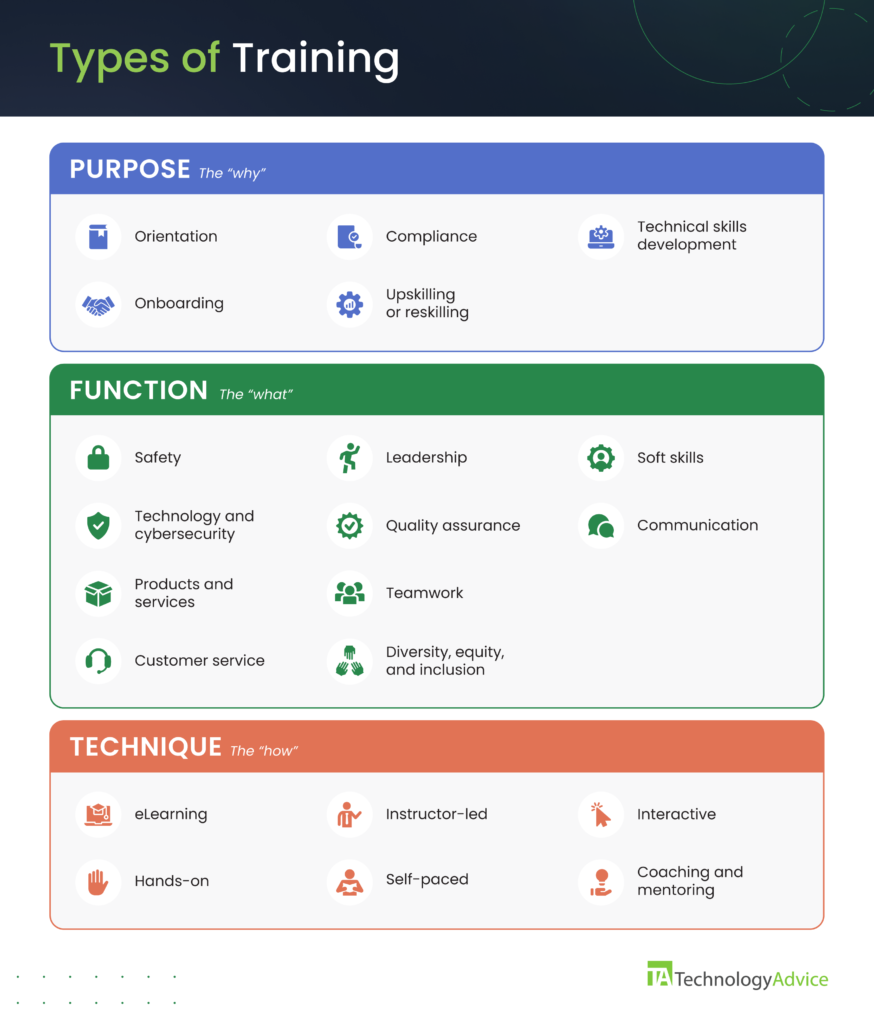Key takeaways
What are employee training programs?
Employee training programs are any structures put in place to give your people the knowledge and skills they need to work within a company. Employee training is a broad category, but it can be broken down into some significant types.
The bare minimum employee training programs businesses of all sizes should offer include:
- Industry- or state-mandated compliance training (such as OSHA training or HIPAA).
- Onboarding training.
- On-the-job (OTJ) training.
Onboarding training typically covers various topics, like company culture, products and services, work standards, tool and equipment usage, and other company policies. OTJ training, meanwhile, uses hands-on learning to teach new hires the immediate skills and competencies they’ll need in their roles.
Employee training can go far beyond these basics, though. Good training can really elevate your team by teaching them new hard and soft skills, creating role clarity, increasing leadership capability, and and other benefits.
What are the benefits of employee training programs?
What are the different types of training?
Company training can take various forms, from role-playing to onboarding, or employee professional development. However, to quickly understand the different types of training, let’s categorize them by purpose, function, and technique.
- Purpose: Training types that cover a broad range of topics closely related to the different development stages of workers on the employee life cycle.
- Function: Training types that cover a narrow topic, usually based on the company’s policies or values or on the employee’s role or department.
- Technique: Training types based on how you present them to the learner, such as instructor-led.
Put simply, purpose is the “why,” function is the “what,” and technique is the “how.” These categories are not mutually exclusive; you should consider all three of them when planning any type of training.

Training by purpose
Purpose-based training types encompass many topics to help companies and employees achieve a particular goal. For instance, offering technical skills development training can aid your company’s recruitment efforts and expand an employee’s knowledge of their role.
Training by function
If purpose is the “why” of a training program, function is the “what.” Training courses by function are more narrow in scope, covering a specific aspect of business practices.
Training by technique
Training by technique covers the “how” of the training process. Different people learn differently, so a good training program implements a few different learning methods. Usually, the most effective training incorporates digital and in-person training techniques, known as blended learning.
Choosing a training program for your business
There are mountains of options available when choosing employee training programs for your company. You need to consider what skills you are trying to train, what goals you are trying to accomplish with the training, and your teaching methods for each program. On top of that, you have to decide what resources will work best for you.
It’s easy to get overwhelmed with all of these choices, so here are some tips:
- Have clear objectives. Outline the specifics of what you are hoping to gain from an employee training program. Consider who is doing the learning, and why. Build your training around those key principles.
- Create a comprehensive plan. Go into as much detail as you are able when planning your training. The more information and resources you provide when implementing a program, the easier it will be to train people in the long-term, and the more aligned they’ll be because of it.
- Ask for feedback. Don’t launch your training and never look at it again. Keep checking on how it’s working, and if it’s accomplishing your objectives. If it isn’t, it’s time to reevaluate the program.
- Invest in effective training resources. Don’t reinvent the wheel if you don’t have to. Take a look at some of the LMS software that’s available, and see if any of it suits your needs.
Read our practical guide for next steps: How to Create a Training Program for Effective Employees






